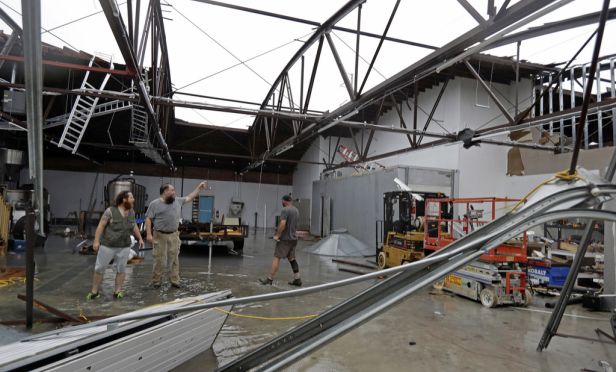 Ethan Hall, right, Michael Jenkins, center, and Nash Fralick, left, examine damage to Tidewater Brewing Co. in Wilmington, N.C., after Hurricane Florence made landfall Friday, Sept. 14, 2018. (AP Photo/Chuck Burton)
Ethan Hall, right, Michael Jenkins, center, and Nash Fralick, left, examine damage to Tidewater Brewing Co. in Wilmington, N.C., after Hurricane Florence made landfall Friday, Sept. 14, 2018. (AP Photo/Chuck Burton)
(Bloomberg) – Hurricane Florence hit North Carolina, leaving more than half a million people without power and facing at least another day of heavy rain and wind.
The storm made landfall near Wrightsville Beach Friday morning as a Category 1 storm, and is now carrying maximum sustained winds of 80 miles (130 kilometers) an hour, menacing the coast with life-threatening storm surges.
Recommended For You
Rivers in the region are already reaching flood stage, according to the National Weather Service. The service also warned of potential of tornadoes in the Carolinas.
24-36 hours remain of a significant threat
"This is not the end of it. Twenty-four to 36 hours remain of a significant threat," Jeff Byard, FEMA's Associate Administrator for the Office of Response and Recovery, said Friday morning. "I hope people bought flood insurance because you are going to need it for this event."
About 525,000 homes and businesses were without power, mostly in North Carolina. Duke Energy Corp. has estimated that as many as 3 million customers, 75% of its total, face potential electricity outages from the storm.
More than 60 guests had to evacuate the Triangle Motor Inn in Jacksonville, North Carolina, in the middle of the night after winds and rain caused "life-threatening damage," including a basketball-sized hole in a corner room, according to city police. Cinder blocks were crumbling and some of the roof collapsed, flooding rooms.
More than 100 people rescued from rising waters
More than 100 people have been rescued from rising waters, the North Carolina's Emergency Management office said on its Twitter account, advising those affected to move to an attic or second story for safety.
The storm surge is forecast to reach a deadly 11 feet (3.4 meters) in some parts of the state. The slow-moving hurricane could drench parts of the Carolinas with rain, producing catastrophic flash flooding, the hurricane center has said.
The total bill for damage from Florence could eventually reach $10 billion to $20 billion, said Chuck Watson, a disaster researcher at Enki Research in Savannah, Georgia. Hundreds of thousands of people have evacuated the coast, more than 1,500 U.S. flights have been canceled, factories have been shut and farmers have rushed to save livestock and crops from the storm's wrath.
Forecast track
On the forecast track, the center of Florence is expected to move inland across the extremes of southeastern North Carolina and eastern South Carolina Friday and Saturday. It will then go northward across the western Carolinas and the central Appalachian Mountains early next week, according to the NHC.
Once the center moves inland, the intensity of the hurricane is set to decrease, according to a forecast discussion posted on the NHC's website.
North Carolina is the largest tobacco grower and ranks second among U.S. states in hog inventory and producing broiler chickens. CoBank ACB, an agricultural lender, estimates damage to North Carolina farming could hit $1 billion before the storm slows.
Along with agriculture, the Carolinas stand as an important regional hub for banking, technology, manufacturing and transportation, accounting for about 4 percent of U.S. gross domestic product, according to a Bloomberg U.S. economic analysis. The path may affect more than 4,000 manufacturing and distribution facilities, potentially hurting sectors including auto-parts and packaged foods, according to Bloomberg Supply Chain data.
Super Typhoon Mangkhut threatening parts of Asia
Florence is hitting the U.S. coast just as Super Typhoon Mangkhut is threatening to spur chaos in parts of Asia. The Philippines placed the main Luzon island under storm alert and said as many as 824,000 Filipinos may have to be evacuated before the storm hits land on Saturday morning.
Got photos to share? We'd like to see them. PropertyCasualty360.com readers who have images of Florence's path can send them via e-mail to [email protected], for inclusion in our coverage.
© 2025 ALM Global, LLC, All Rights Reserved. Request academic re-use from www.copyright.com. All other uses, submit a request to [email protected]. For more information visit Asset & Logo Licensing.








